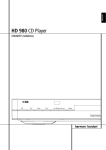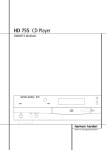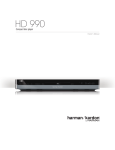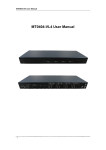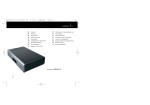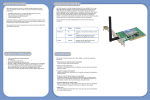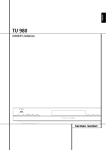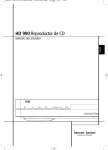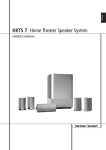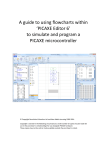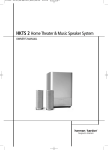Download AKG CD-player HD 970
Transcript
HD 970 CD Player OWNER’S MANUAL HD 970 Play Pause Stop SKip/Search Display Power for the Digital Revolution® Table of Contents 2 3 4 4 5 6 7 9 10 10 10 11 11 11 12 12 12 12 12 13 13 13 13 14 15 16 Typographic Conventions Introduction Information Unpacking Front Panel Controls Rear Panel Connections Remote Control Functions Installation Operation Loading and Unloading Discs Normal Play Display Dim Time Display Disc Info Search Skip Folder +10/-10 Input/Source Selection Programmed Play Operation Programmed Play Checking Program Contents Clearing Programs Repeat Play Troubleshooting Guide Technical Specifications Declaration of Conformity We, Harman Consumer Group International 2, route de Tours 72500 Château-du-Loir, FRANCE declare in own responsibility, that the product described in this owner’s manual is in compliance with technical standards: EN 55013:2001+A1:2003 EN 55020:2002+A1:2003 EN 61000-3-2:2000 EN 61000-3-3.1995+A1:2001 EN 60065:2002 Jurjen Amsterdam Harman Consumer Group International 01/05 Typographic Conventions In order to help you use this manual with the remote control, front panel controls and rear panel connections, certain conventions have been used. EXAMPLE – (bold type) indicates a specific remote control or front panel button, or rear panel connection jack. EXAMPLE – (bold type) indicates a message in the front panel information display. 1 – (number in a square) indicates a specific front panel control. a – (number in an oval) indicates a button or indicator on the remote. ¡ – (number in a circle) indicates a rear panel connection. 2 TABLE OF CONTENS Introduction Thank you for choosing Harman Kardon HD 970 CD player. The HD 970 is an exceptionally well-engineered product that offers high performance and ease of use. Along with conventional CD audio discs, the HD 970 is also compatible with MP3 data from CDs and most recordable CD formats. We ask that you take a few minutes to read through this Owner’s Manual to familiarize yourself with the controls and functions. This brief investment of time will yield dividends in the form of years of listening pleasure. If you have any questions about this product, its installation or operation, please contact your dealer, as they are your best source of local information. Description and Features Ever since its introduction in 1992, Harman Kardon RLS (Real-time Linear Smoothing) conversion technology has been hailed as an efficient, high performance means of transforming the, at that time 16-bit, digital signal from CD to high quality analog. The short RLS signal path resulted in hitherto unknown clarity and detail, in combination with awesome dynamic resolution of the critical bass frequencies. RLS-II was a natural, yet radical evolution of the original RLS concept. Since then, dramatic progress has been made in Digital Signal Processing, allowing the integration of DSP's in a standalone CD Player and the implementation of a very powerful algorithm in the digital domain: the birth of the RLS-III. Using theoretical roots of the RLS, RLS-III has set new standards for dynamic range and shifted noise to an absolute non-audible frequency range with very high jitter rejection. The result is an astonishing common signal format of 24 bits at a sampling frequency of 384 kHz. This 24 bits/384 kHz signal format allows Harman Kardon engineers to take a minimalist approach to the subsequent analog filtering, without paying any penalty in the form of the aliasing errors and artifacts. Harman Kardon's analog processing legacy has been expressed to its optimal level in the output stage of the HD 970 with High Definition, Wide Bandwidth and Low Feedback circuitry in a pure Class A configuration, using only high grade components. ■ Asynchronous Digital Processing for Highest Possible Jitter Rejection based on a 32bit DSP ■ Real-time Linear Smoothing III ■ Two Digital Inputs (One Optical and One Coaxial) for Dramatic Sound Quality Improvement of External Devices ■ CD Playback with CD Text Functionality, MP3 Playback with ID3 Tag Information ■ Digital Output for Direct Connection to Outboard Digital-to-Analog Converters ■ Sophisticated Programming Features to Automatically Play Tracks in Preprogrammed or Random Order ■ Full compatibility with CD-R and CD-RW format to play (finalized) recordable and erasable discs without problems. A unique feature of the HD 970 is that it allows other source components to be played back using the high-grade audiophile digital-to-analog convertors inside the CD player. Especially source components using older and less powerful convertors will benefit from this feature. Important Note: The player will only output 2-channel PCM signals. Neither multi-channel Dolby Digital or DTS nor their 2-channel downmix signals will be output. CLASS 1 LASER INTRODUCTION 3 Information Important Safety Information Verify Line Voltage Before Use Your HD 970 has been designed for use with 230-volt AC current. Connection to a line voltage other than that for which it is intended can create a safety and fire hazard, and may damage the unit. If you have any questions about the voltage requirements for your specific model, or about the line voltage in your area, contact your selling dealer before plugging the unit into a wall outlet. Do Not Use Extension Cords We do not recommend that extension cords be used with this product. As with all electrical devices, do not run power cords under rugs or carpets or place heavy objects on them. Damaged power cords should be replaced immediately by an authorized service depot with cords meeting factory specifications. Handle The AC Power Cord Gently When disconnecting the power cord from an AC outlet always pull the plug, never pull the cord. If you do not intend to use the unit for any considerable length of time, disconnect the plug from the AC outlet. Do Not Open The Cabinet There are no user-serviceable components inside this product. Opening the cabinet may present a shock hazard, and any modification to the product will void your guarantee. If water or any metal object such as a paper clip, wire or a staple accidentally falls inside the unit, disconnect it from the AC power source immediately, and consult an authorized service station. CAUTION: The HD 970 uses a laser system. To prevent direct exposure to the laser beam, do not open the cabinet enclosure or defeat any of the safety mechanisms provided for your protection. DO NOT STARE INTO THE LASER BEAM. To ensure proper use of this product, please read this owner’s manual carefully and retain it for future use. Should the unit require maintenance or repair, please contact your local Harman Kardon service station. Refer servicing to qualified personnel only. 4 INFORMATION Installation Location ■ To assure proper operation, and to avoid the potential for safety hazards, place the unit on a firm and level surface. When placing the unit on a shelf, be certain that the shelf and any mounting hardware can support the weight of the product. ■ Make certain that proper space is provided both above and below the unit for ventilation. If this product will be installed in a cabinet or other enclosed area, make certain that there is sufficient air movement within the cabinet. ■ Do not place the unit directly on a carpeted surface. ■ Avoid installation in extremely hot or cold locations, or an area that is exposed to direct sunlight or heating equipment. ■ Avoid moist or humid locations. Cleaning When the unit gets dirty, wipe it with a clean, soft dry cloth. If necessary, wipe it with a soft cloth dampened with mild soapy water, then a fresh cloth with clean water. Wipe dry immediately with a dry cloth. NEVER use benzene, thinner, alcohol or any other volatile cleaning agent. Do not use abrasive cleaners, as they may damage the finish of metal parts. Avoid spraying insecticide near the unit. Moving The Unit Before moving the unit, be certain to disconnect any interconnection cords with other components, and make certain that you disconnect the unit from the AC outlet. Unpacking The carton and shipping materials used to protect your new HD 970 during shipment were specially designed to cushion it from shock and vibration. We suggest that you save the carton and packing materials for use in shipping if you move or should the unit ever need repair. To minimize the size of the carton in storage, you may wish to flatten it. This is done by carefully slitting the tape seams on the bottom and collapsing the carton down to a more twodimensional appearance. Other cardboard inserts may be stored in the same manner. Packing materials that cannot be collapsed should be saved along with the carton in a plastic bag. If you do not wish to save the packaging materials, please note that the carton and other sections of the shipping protection are recyclable. Please respect the environment and discard those materials at a local recycling center. Front-Panel Controls HD 970 Play Pause Stop SKip/Search Display Open/Close 1 Main Information Display 2 Power On/Off (Standby) 3 Open/Close 4 Play 5 Pause 6 Stop 7 Skip/Search (Previous) 8 Skip/Search (Next) 9 Dimmer 1 Main Information Display: This display delivers messages and status indications to help you operate the CD player. 6 Stop: Press this button to stop the disc currently being played or to exit program mode (see page 13 for complete information). 2 Power On/Off (Standby): Press the button once to turn the CD player on, press it again to put the unit in the Standby mode. 7 Skip/Search (Previous): Press this button to move backward through the music tracks on a CD disc. Keep the button pressed to search backwards at one of the available speeds. 8 Skip/Search (Next): Press to move forward through the music tracks on a CD. Keep the button pressed to search forwards at one of the available speeds. 3 Open/Close: Press this button to open or close the Disc Tray. 4 Play: Press to initiate playback or to resume playback after Pause has been pressed. 5 Pause: Press this button to momentarily pause playback. To resume playback, press the button again. If a CD is playing, the sound will be muted. 9 Dimmer: Press this button to reduce the brightness of the Information Display by 50% or to turn the display off completely in the following order: FULL BRIGHTNESS ➜ HALF BRIGHTNESS ➜ OFF ➜ FULL BRIGHTNESS. Important Note: When the unit is turned off (to Standby), pressing the Play button 4 9 on the front or on the remote will automatically turn on the player and start playback. FRONT-PANEL CONTROLS 5 Rear-Panel Connections ¡ Digital Output ™ Audio Outputs £ Remote Control Input ¢ Remote Control Output ∞ AC Power Cord § Coaxial and Optical Digital Inputs ¡ Digital Output: Connect this jack to the coaxial digital input of an external digital-to-analog converter for direct access to the digital signals of the CD player or the external digital audio source. DO NOT connect this jack to the standard audio inputs of any device. £ Remote Control Input: Connect the output of a remote infrared sensor or the remote control output of another compatible Harman Kardon product. This will enable the remote control system to operate even when the front panel Remote Sensor 3 is blocked. It will also allow use of the CD player with optional, external control systems. ∞ AC Power Cord: Connect this plug to an AC outlet. If the outlet is switch controlled, make certain that the switch is in the ON position. ™ Audio Outputs: Connect these jacks to the CD audio inputs of your receiver, surround processor or preamplifier. 6 REAR-PANEL CONNECTIONS ¢ Remote Control Output: Connect this jack to the input of another compatible Harman Kardon remote controlled device to have the remote sensor on the CD player provide signals to other products. § Coaxial and Optical Digital Inputs: Connect these jacks to the coaxial or optical digital output of an external audio source. This will enable you to have the digital-to-analog conversion of that source done by the highgrade audiophile digital-to-analog convertors in the HD 970 rather than the (older ones) in the external source, for better audio quality. Remote Control Functions 0 1 2 3 4 5 6 7 8 9 A B C D E F G H I J Power Off Power On Numeric Controls Program Button Clear Button Repeat Button Repeat A › B Button Skip Buttons Search Buttons Play/Pause Button Stop Button +10/-10 Buttons Random Button Time Button Check Button Open/Close Button Display Button Folder Buttons Source Button Info Button REMOTE CONTROL FUNCTIONS 7 Remote Control Functions 0 Power Off: Press this button to put the unit in the Standby mode. 1 Power On: Press this button to turn on the CD player. Note that in order for the Power On button to operate, AC power must be applied to the unit, and the Status Mode Indicator 2 should glow orange (See page 11 for more information). The unit will also turn on when the Play 49 or Open/Close 6B button is pressed. 2 Numeric Controls: Press these buttons to select a specific track on a disc. The unit will immediately search for the track and begin to play it. For tracks 1 through 9 on a disc, you need only press the desired number. For tracks 10 and above, the second and third digit of the number must be entered within two seconds of the first digit. (See page 10 for more information.) These buttons are also used to enter track numbers into the memory for pre-programmed play lists. (See page 13 for complete information on programming the CD player.) 3 Program Button: Press this button to begin the process of programming the CD player to play the tracks on a disc in a specific order. Once the button is pressed, enter each of the desired track numbers in quick succession using the Numeric Controls 2. When you have entered the tracks to be played, press the Play button 9 to begin the programmed sequence. (See page 13 for complete information on programming the CD player.) 4 Clear Button: Press this button to remove selected or all tracks from the programmed sequence. (See page 13 for complete information on programming the CD player.) B +10/-10 Buttons: Press the +10 button to move to the 10th track after the current track playing. Press the -10 button to move to the 10th track before the track currently playing. 5 Repeat Button: Press this button once to repeat only the track that is currently being played, and note that the REPEAT and ONE indicators will light in the Information Display. Press the button a second time so that the REPEAT and ALL indicators are illuminated to repeat all tracks on the disc. (See page 14 for more information on Repeat Play.) C Random Button: Press this button to have all of the tracks played in a random order. (See page 10 for more information.) 6 Repeat A › B Button: Press this button to repeat a segment of the disc. Press the button once to mark the start of the portion to be repeated. Press it again at the end of the desired sequence. The marked passage will play continuously until the Stop button A is pressed. (See page 14 for more information on Repeat Play.) 7 Skip Buttons: Press one of these buttons to move to the next track fl·, or to move back to the previous track ‡fi (See page 12). 8 Search Buttons: Press one of these buttons to search forward — or backwards ‚ through a disc to locate a particular portion of the selection being played. Holding the buttons pressed for some seconds will increase the search speed (see page 12). 9 Play/Pause Button: Press this button to start the playback of a CD. If the CD drawer is open, pressing this button will automatically close the drawer. Press this button once during playback to momentarily stop a disc. When the button is pressed again, the disc will resume play at the point it was stopped. A Stop: Press this button to stop the disc currently being played or to escape from the program mode (see page 13 for complete information). D Time Button: Press this button to select the time display. In normal operation, the display will show the running time of a track being played. Press the button once to check the time remaining for the track in play. Press the button a third time to view the elapsed time for the CD being played, and a last time for the total play time remaining for the disc in play (See page 11). E Check Button: Press this button to check the order of tracks programmed into the CD player's memory. (See page 13 for complete information on programming the CD player.) F Open/Close: Press this button to open or close the disc drawer. The drawer may also be closed by pressing the Play button 4 9, or by gently pressing the edge of the drawer. However, we do not recommend pushing the drawer, as damage to the transport mechanism may result. G Display Button: Press this button once to dim the front panel display to half brightness. Press it again to turn the display lights off completely. Another press will return the display to normal brightness. H Folder Buttons: Press the Folder + button to move to the next folder with MP3 data, and the Folder - button to move to the previous folder with MP3 data. I Source Button: Press this button to switch between the CD player's output and the output of other sources connected to one of the digital inputs § (See page 12 for more information). J Info Button: Pressing this button consecutive times shows the different CD Text information available on a CD, or ID3 and other information available on a disc with MP3 data. To return to normal Track number / Time indication press the Time button D. (See page 11 for more). 8 REMOTE CONTROL FUNCTIONS Installation To prevent possible damage to your speakers and other components in your audio system, it is important that ALL components, including the HD 970 and your receiver or preamp and amplifiers, are turned off and unplugged from their AC power source when installing any new component. Connecting the HD 970 to your audio system is simple. Using standard RCA-to-RCA interconnect cords, connect the left and right Audio Output jacks ™ on the rear panel to the CD input jacks on your receiver, surround processor or preamplifier. If your system includes an optional external digital-to-analog converter, or if you are using a receiver or other processor that has the capability to decode PCM digital input signals, connect the Digital Output jack ¡ to the Coaxial Digital input on the decoder. Make certain to use a coaxial-style interconnect cable, as standard audio cables will not perform as well. If you have additional external audio sources, you might want to connect their coaxial or optical digital output to the Coaxial or Optical Digital Inputs § on the rear panel of the CD player. This will enable you to use the audiophile high-grade digital-to-analog convertors and processing power in the HD 970 rather than the (older and less-powerful) convertors of your external source. Note that in order to hear the sound from the external source when connected like this, the input of your amplifier or receiver should be the one to which the HD 970 is connected. NOTE: When replacing batteries, always replace both at the same time. When the unit will not be used for an extended period of time, it is also a good idea to remove the batteries so that the potential for corrosion or damage is avoided. If the HD 970 is installed behind a cabinet or other obstruction that may block the path between the front-panel Remote Sensor and the location of the remote, an optional external IR sensor may be used. Connect the sensor to the Remote IR-In Jack £ on the rear panel. This jack may also be connected to the IROutput jack of another compatible Harman Kardon component or a compatible IR-systemremote product. You may also use the IR Sensor in the HD 970 to send commands to other compatible remote controlled products. Connect the Remote IROut jack ¢ to the input of the other product or system. Connect the power to a nonswitched AC wall outlet or to the accessory outlet on the rear of another audio device in your system and you are ready to go! NOTE: When using the accessory outlet on another product to power the HD 970 make certain that it has the compatibility to power a device that draws at least 14 watts of current in addition to being able to handle the requirements of the other devices that may be plugged into the accessory outlets. If you use a “switched” outlet, it is important to remember that the host product must be turned on in order for the HD 970 to operate. Install two AA batteries by turning the remote over so that you are holding the bottom side up. Press lightly on the embossed arrow on the cover and gently slide the cover towards you in the direction of the arrow. Insert the batteries inside the compartment, being careful to follow the + and – polarity indications at the bottom of the compartment. Replace the cover by placing it on the remote and sliding it back towards the top of the remote. INSTALLATION 9 Operation Loading and Unloading Discs To load a disc, first turn the unit on (if not so already) by pressing the Power Switch 2 on the front panel or the Power On button 1 on the remote, then press the Open/Close button 3 F taking care to make certain that the space in front of the drawer is not obstructed. When the unit is turned off (to Standby), pressing the Play button 4 9 on the front or on the remote will automatically turn on the CD player and start playback. Load the disc in the tray with the printed (label) side facing up. Make certain that the disc is centered in the tray. Either 12cm (5") or 8cm (3") discs may be used. When an 8cm disc is played, it should be carefully centered within the smaller ridges inside the cassette drawer. To remove a disc from the player, press the Open/Close button 3 F. The drawer will open, allowing the disc to be removed. Disc Handling Notes When loading or unloading discs, it is best to hold them by the edges. While Compact Discs are very reliable, rough handling may damage them. Avoid scratching the bottom (non-printed) side of discs, or any handling which will leave fingerprints. To avoid damage to the disc and player, always seat discs so that they are centered in the tray. Do not lift the player while the disc tray is opening or closing, as this may cause the disc to unseat from the tray and possibly jam. Normal Play Labeled Surface To retract the drawer back into the player after loading a disc, press the Open/Close button 3 F. When the drawer is closed the display will indicate the total number of tracks on the disc and the total running time of the disc. The drawer will also close when the Play button 4 9 is pressed. The drawer will close and the disc will start playing the first track. 10 OPERATION To play a disc, first turn the HD 970 on using the Power Switch 2 on the front panel or the Power On button 1 on the remote control. When the unit is turned off (to Standby), pressing the Play button 4 9 on the front or on the remote will automatically turn on the CD player and start playback. To load or change a disc open the disc drawer by pressing the Open/Close button 3 F. Place a disc in the tray following the instructions shown above. Pressing the Open/Close button once a disc has been carefully seated will close the disc drawer while the message CLOSING will appear in the information display. As soon as the tray is closed the display will show the message READING while the table of content (TOC) of the disc is read. Note that particulary with CD-RW discs this tracking may take some time due to the reflectibility and data structure different from normal discs. Afterwards the Information Display will show the total number of tracks on a disc and the total running time of the disc. Note that with MP3-CDs the total running time will not be shown. _ A B TRACK HOUR AUTO MIN SEC The drawer will also close when the Play button 4 9 is pressed. The drawer will close and the disc will start playing the first track. To play all of the tracks on the disc in order, press the Play button 4 9. A play indication fl will appear in the Information Display 1. To play all of the tracks in random order, press the Random button C. The RANDOM indicator will light when that mode is in use. Random can be activated also while a track is playing. When Random is activated while programmed play is in use (see page 13), all programmed tracks will be played in random order. You may also select a specific track by pressing the Skip buttons 7 7 until the desired track number is displayed (see page 12). The track may also be selected directly by entering the track number via the Numeric Controls 2, simply enter the track number by pressing the buttons that correspond to the desired track. Note that when a two- or three-digit track number is being entered, the second and third digit of the number must be pressed within two seconds of the first digit. After the track is selected, press the Play button 4 9. Operation While the disc is playing, the track being played will show as a number in the middle of the display just below the word TRACK. The elapsed time of the track being played will also appear in the display (see figure page 10). As a disc plays, the track numbers will change, and the time will reset to at the start of each new track. To momentarily pause the play of a disc, press the Pause button 5 9. Note that a Pause indication ± will appear in the display to remind you that the disc is paused. Press either the Play button 4 9 or the Pause button 5 9 to resume normal play. To stop the disc, press the Stop button 6 A. When the Stop button is pressed the display again will show the total number of tracks and total running time of the disc. To remove a disc from the player, press the Open/Close button 3F. To prevent dirt and dust from entering the unit, do not leave the disc tray open. To place the unit in a Standby mode, press the Power Switch 2 on the front panel or the Power Off button 0 on the remote. The display will show a STANDBY message for a moment and the Status Mode Indicator will glow orange, indicating that the unit is off, but ready to accept a Power On command from the remote. If the disc drawer is open, it will automatically close when the unit is placed in the Standby mode. This ensures that the unit will not be harmed from dust, dirt or inadvertent damage to the drawer mechanism. Note that the unit is not removed from AC main power when it is in the Standby mode but its power consumption is reduced to a low value. To remove the AC power completely from the unit its Power Cord ∞ must be plugged into a switch controlled AC outlet that is turned off. We recommend to use the switched AC outlet on the rear side of a receiver or amplifier. When that AC outlet will be turned on, the HD 970 will always turn to the Standby mode even if it was on before the AC power was removed. Display Dim Disc Info In some situations, it may be desirable to reduce the brightness of the display or to turn it off completely. To do this, press the Display button G on the remote once to dim the display to half brightness. Press it again to turn the display off. A third press will return the display to normal level. The HD 970 is able to show CD-Text information from CD discs, as well as ID3 tag and other information from discs containing MP3 data. Please note that not all CD's contain CD-Text. In that case, the Main Information Display will show NO CD-TEXT and will return to the time mode previously selected. Time Display If you play back a CD that contains CD-Text information the TEXT indicator will light in the Information display 1. During play, the Artist name, Track name and Album name can be made visible on the Main Information Display 1 by pressing the Info button J several consecutive times. Each press of the Info button J will show the next line of information. If the text is longer than 12 characters, the text will scroll continuously from right to left on the Main Information Display 1. The CD player's time display is capable of showing a wide range of information about a CD. In normal operation the display will show the total running time of a CD after the disc is first put in the unit. When the disc is played, the display will show the running time of a track in play. Each time the track changes, the time display will reset to and begin to increase again as the new track plays. To view the time remaining on an individual track, press the Time button D on the remote once. The display will now show the time left in the track in play, and a ”-” will light in front of the time display as a reminder of the display’s status. To view the elapsed time of the disc currently playing, press the Time button D again. To view the total time remaining to play on the disc, press the Time button again, a number greater than the formerly shown track remaining time (except the last track of the disc is played) will appear in the display, again with a ”-” in front. If you play a disc with MP3 data, the File name, the Data Rate (Constant Bit Rate CBR and Variable Bit Rate VBR) and Folder/Root name can be made visible on the Main Information Display 1 by pressing the Info button J several consecutive times. If ID3 tag information is included in the MP3 data, the Artist name, Track name and Album name can also be made visible. Each press of the Info button J will show the next line of information. If the text is longer than 12 characters, the text will scroll continuously from right to left on the Main Information Display 1. To return to the normal Track/Time indication press the Time button D. When the Time button is pressed again the display will return to show the running time of the track in play. Note: When a program is played (see page 13), all time modes are selectable too except the total time remaining on the disc. The time mode is not available when playing back discs containing compressed MP3 data. OPERATION 11 Operation Search Skip +10/-10 If you wish to quickly scan through a disc to locate a particular passage or track, press and hold the Search buttons. The Forward Search button — 8 8 plays the disc forward in high speed, while the Reverse Search button ‚ 7 8 plays the disc backwards in high speed. Holding the buttons pressed will tripple the search speed after 3 seconds. When the desired part of the disc is heard, release the Search button to resume normal play speed. To move from one track on the disc to another during play mode, press one of the Skip buttons. Pressing the Forward Skip button fl· 8 7 will move you forwards through the disc, one track at a time, while pressing the Reverse Skip button ‡fi 7 7 once will move you back to the start of the actual track (as long as >3 second of the track have elapsed) and pressing it multiple times will move you back one track at a time. Holding any Skip button pressed will scan quickly through all tracks on the disc, as described in the previous paragraph. Due to the compressed format of MP3 data, discs can contain several hundred audio tracks. In order to find the right track within these hundreds of tracks, the CD player lets you skip through the contents of your disc in steps of 10 tracks. Press the +10 button B to change to the 10th track after the track currently playing. If there are less then 10 tracks remaining on the disc, the last track will be played. Press the -10 button B to change to the 10th track before the track currently playing. If there are less then 10 tracks since the beginning of the disc, the first track will be played. The Skip buttons may be used when the CD player is either playing or stopped. If the unit is stopped, the Skip buttons may be used to locate the first track to be played. The Play button 4 9 must be pressed to begin play. If the Skip buttons are used while the unit is already playing (as described above), the audio output will stop while the new track is located, and play will automatically resume with the new track. Input/Source Selection If the Skip buttons are pressed when program play is in use (see page 13), the unit will move from one programmed track to another. Folder Discs containing compressed MP3 data often contain several directories and folders with data. To show the name of the current directory or folder playing, press one of the Folder +/buttons H once. To change to the next directory or folder, press the Folder + button H again within three seconds after the first press. For the previous directory or folder, press the Folder - button H. The CD player counts each directory and folder as one folder. The player starts to count in the main directory, and pressing the Folder + button H will start playback of the first folder in this directory. Pressing the Folder + button H again will start playback of the second folder in the directory. Continue pressing the Folder + button H until the last folder in the directory has been played. At this time, pressing the Folder + button H will start playing the next directory. Note that the Folder +/- buttons do not function when the CD player is playing the tracks of a disc containing MP3 data in random order. 12 OPERATION A unique feature of the HD 970 is that it allows other source components to be played back using the high-grade audiophile digital-to-analog convertors inside the CD player. Especially source components using older and less powerful convertors will benefit from this feature. Connect the coaxial or optical digital output of the external source component to the Coaxial or Optical Digital Inputs § on the rear panel of the CD player. In order to select the external source component for playback, press the Source Button I. The first press of this button will show the input currently played, indicated by PLAYER for the CD player, COAXIAL IN (Digital in 1) or OPTICAL IN (Digital in 2). Within 2 seconds, press the Source Button I again until the requested source has been selected. Note that in order to hear the sound from the external source when connected via the HD 970, the input of your amplifier or receiver should be the one to which the HD 970 is connected. Important Note: The player will only output 2-channel PCM signals. Neither multi-channel Dolby Digital or DTS nor their 2-channel downmix signals will be. Programmed Play Operation The HD 970’s advanced programming capability enables you to select certain tracks, to preset the order in which these tracks play, and to clear specific programmed tracks after the program was made. Programmed Play Programmed play allows you to program up to 32 tracks into the HD 970’s memory. To begin programming the CD player, make sure that the unit is in Stop mode, then press the Program button 3. The PROGRAM indicator will light in the Information Display 1, the number 001 will blink below the Program indicator, showing the track number selected, and PROG-01: 001 will appear in the Information Display, replacing the track time. This indicates that you are about to program the first track. You may now begin to enter the tracks in the order in which you wish to have them play. To select a track on the disc, press the Numeric buttons 2 corresponding to the desired track, be certain to enter the second and/or third number of two- or three-digit numbers within two seconds after the first number was entered. You may also use the Skip buttons 7 8 7 to select a track. When the track is selected, press the Program button 3. Note that the program-step indication on the right side of the Information Display will change to PROG-02: 001. You may now select another track for the next program step, following the instruction shown above. When the track is selected, press the Program button 3 again. Repeat this procedure for each program step until you have completed the desired programming. Press the Stop button 6 A once to complete a program sequence, or press Play 4 9 to begin immediate play of a program sequence. If the maximum of 99 program steps is reached, the program-step indication at the right side of the Information Display will go out, and the disc and track that have been programmed as the first program step will be shown. Once a program list has been entered, press the Play button 4 9 to begin listening to the sequence. After the entire program has been played, the CD player will stop. As long as the Stop button 6 A has not been pressed twice and the PROGRAM indicator remains lit, you may repeat the programmed-play sequence again by pressing the Play button 4 9. Editing a Program A program can be edited even after it was completed by pressing the Stop button 6 A once: Each time you press the Program button 3 the track number and program step number will be displayed in the programmed order, but with steady tracks numbers (not blinking) in contrast to the programming mode. As soon as the track number starts blinking (this will take 1 second), the appropriate program step number shown at the left side is not programmed yet; now you can change the track number with the Skip buttons 7 8 7 or the Numeric buttons 2 as described above and add it to the program list by pressing the Program button 3. Pressing the Stop button 6 A twice will return to normal mode and the PROGRAM indicator will go out, but the program will stay in memory and can be recalled easily by pressing the Program button. But pressing the Clear button 4 (see below) or opening the disc drawer by pressing Open/Close 3 F, will erase the program information from the unit’s memory. Checking Program Contents To check the contents of a program while the unit is stopped at first note that the PROGRAM indicator is lit (otherwise press Program) and the program step indication PROG-01: is not lit (otherwise press Stop once). Each time the Check button E is pressed now, the Information Display will step through each of the programmed tracks. To cancel the check mode press the Stop button twice. Clearing Programs To clear a single track from the program list, press the Program button 3 until the track to be deleted from the program sequence appears in the Information Display 1.When the track number appears, press the Clear 4 once, the track selected will be deleted and the track number will be replaced by the next programmed one. Now you can delete that track too with the Clear button or press the Stop button 6 A and again the Program 3 button to select lower track numbers to be deleted. When the unit is stopped and the program step indication PROG-01: 001 is not lit (otherwise press Stop once), but the PROGRAM indicator is still lit (otherwise press Program 3) you may clear the entire contents of a program by pressing the Clear button 4. Important Note: When you’ve pressed the Program button 3 (once or several times) and the track number on the right starts blinking, the appropriate program step number (e.g. PROG-02: 008) shown at the left display side is not programmed yet. Do not continue to press the Program button now, otherwise the track selected will be memorized too. If you´re in doubt, press Stop button 6 A and start the procedure again with Program 3. IMPORTANT NOTE: Tracks programmed as described above in chapter ”Programmed Play” can be played repeatedly too: When you press Repeat 5 once after a program is created (the PROGRAM indicator must be lit, (otherwise press Program) and the program is played, the REPEAT 1 indicator will light and the track currently playing will be repeated continuously. If Repeat is pressed twice REPEAT ALL will be displayed, all programmed tracks will be played subsequently and the sequence will be repeated continuously until the Stop button is pressed. PROGRAMMED PLAY OPERATION 13 Repeat Play Operation Repeat Play The HD 970’s programming system enables you to repeat either a single track, the entire disc (respectively all programmed tracks) or a specially programmed passage that you select. Repeat One Track To repeat the track in play, press the Repeat button 5 once.The REPEAT and 1 indicators will light and the track will continue to play over and over again continuously. If the track is changed by pressing the Skip buttons 7 8 7 while the Repeat function is in use, the newly selected track will be played normally. To stop the repeat play, press the Stop button 6 A or press the Repeat button 5 until the REPEAT indicator goes out. 14 REPEAT PLAY OPERATION Repeat All Tracks To repeat all of the tracks on a disc during play mode, press the Repeat button 5 until the REPEAT and ALL indicators light up. When you see these indicators, the entire disc or all programmed tracks will play through to the end, and then start again from the beginning. The disc will play continually until the Stop button 6 A is pressed. Repeat A–B The CD player may be programmed to repeat any section within a track, or a complete passage or program that includes material in a series of tracks. To program the unit for A–B play, first locate the point on the disc where you wish to begin the repeated section. At that point, press the Repeat A–B button 6. The REPEAT indicators will light in the Information Display and an A– indicator to show that the program process has started. Let the disc continue to play or press the Search — button 7 8 8 or Skip fl· button 7 8 7 on the front or remote until you have reached the end of the section to be repeated. When the end point is reached, press the Repeat A–B button 6 again. Note that the REPEAT and A–B indicators will now be illuminated. Once the Repeat A–B button 6 is pressed for the second time to complete the programming, the CD player will automatically go to the beginning of the selected passage and continue to play the section over and over. To resume normal play press the Repeat A–B button 6 again. The REPEAT and A–B indicators will go out, and the rest of the disc will play normally. IMPORTANT Note: Tracks programmed as described before in chapter ”Programmed Play” can be repeated too: When you press Repeat 5 once after a program is created (the PROGRAM indicator must be lit, otherwise press Program) and the program is played, the REPEAT 1 indicator will light and the track currently playing will be repeated continuously. If Repeat is pressed twice REPEAT ALL will be displayed, all programmed tracks will be played subsequently and the sequence will be repeated continuously until Stop is pressed. Troubleshooting Guide TROUBLE SHOOTING GUIDE SYMPTOM CAUSE SOLUTION No lights on Front Panel • No AC power • Make certain AC power cord is plugged into a live outlet. Remote does not appear to operate • Power Switch turned off • Weak batteries • Blocked sensor • Turn on Power Switch. • Install fresh batteries, observing polarity indications. • Remove obstructions from the front panel sensor or connect a remote sensor to the Remote In jack on the rear panel. Front panel lights, but CD does not play • Disc upside down • Reload disc with label side facing up. Play indicator lights, but no sound is heard • Poor connections • Make certain connections are secure and made to the correct (e.g., CD) input. • Select CD source on receiver or preamp. • Wrong source connected Sound skips or stutters during play • Disc may be damaged • Surface vibrations • Try another disc. • Isolate the unit from vibration by placing it on a firm surface or move it further away from speakers. Sound is continually distorted • Incorrect input • Make certain that the analog Audio Outputs ™ of the CD player are connected to a line level audio input, NOT to a digital audio or phono input. ERROR lights up continuously in the display • Various • Turn the unit off and on again. If the problem persists, turn the AC power to the CD player off and on. TROUBLESHOOTING GUIDE 15 Technical Specifications Signal Format Sampling Frequency D/A Conversion Oversampling 32 kHz to 96 kHz Multi-Level Delta-Sigma 24 Bits/384 kHz Asynchronous Sample Rate Convertor Discrete Analog Output Section Error Correction Frequency Response Total Harmonic Distortion (THD) Dynamic Range Signal-to-Noise Ratio Channel Separation Line-Output Level CIRC System 20 Hz – 20 kHz +0/-0.5dB <0.0009% @1kHz > 116 dB 116 dB > 115 dB 2.0 V General Power Requirement Power Consumption Dimensions Height Width Depth Weight 230V/50 Hz <10 Watts (On) 63mm 440mm 332mm 4.6 kg Depth measurement includes knobs, buttons and connection jacks. Height measurement includes feet and chassis. All features and specifications are subject to change without notice. Harman Kardon is a registered trademark, and Power for the digital revolution is a trademark, of Harman Kardon, Inc. 250 Crossways Park Drive, Woodbury, New York 11797 www.harmankardon.com Harman Consumer Group International: 2, route de Tours, 72500 Château-du-Loir, France © 2005 Harman Kardon, Incorporated Part 321-A00HD970-0010
















